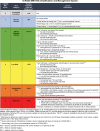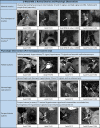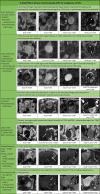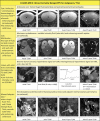O-RADS MRI Risk Stratification System: Guide for Assessing Adnexal Lesions from the ACR O-RADS Committee
- PMID: 35040672
- PMCID: PMC8962917
- DOI: 10.1148/radiol.204371
O-RADS MRI Risk Stratification System: Guide for Assessing Adnexal Lesions from the ACR O-RADS Committee
Erratum in
-
Erratum for: O-RADS MRI Risk Stratification System: Guide for Assessing Adnexal Lesions from the ACR O-RADS Committee.Radiology. 2023 Jul;308(1):e239017. doi: 10.1148/radiol.239017. Radiology. 2023. PMID: 37489996 No abstract available.
Abstract
MRI plays an important role as a secondary test or problem-solving modality in the evaluation of adnexal lesions depicted at US. MRI has increased specificity compared with US, decreasing the number of false-positive diagnoses for malignancy and thereby avoiding unnecessary or over-extensive surgery in patients with benign lesions or borderline tumors, while women with possible malignancies can be expeditiously referred for oncologic surgical evaluation. The Ovarian-Adnexal Reporting and Data System (O-RADS) MRI Committee is an international collaborative effort formed under the direction of the American College of Radiology and includes a diverse group of experts on adnexal imaging and management who developed the O-RADS MRI risk stratification system. This scoring system assigns a probability of malignancy based on the MRI features of an adnexal lesion and provides information to facilitate optimal patient management. The widespread implementation of a codified reporting system will lead to improved interpretation agreement and standardized communication between radiologists and referring physicians. In addition, it will allow for high-quality multi-institutional collaborations-an important unmet need that has hampered the performance of high-quality research in this area in the past. This article provides guidelines on using the O-RADS MRI risk stratification system in clinical practice, as well as in the educational and research settings.
© RSNA, 2022 See also the editorial by Levine in this issue.
Conflict of interest statement
Figures








Comment in
-
MRI O-RADS: Learning about the New Risk Stratification System.Radiology. 2022 Apr;303(1):48-50. doi: 10.1148/radiol.211307. Epub 2022 Jan 18. Radiology. 2022. PMID: 35040679 No abstract available.
References
-
- Andreotti RF , Timmerman D , Strachowski LM , et al . O-RADS US Risk Stratification and Management System: A Consensus Guideline from the ACR Ovarian-Adnexal Reporting and Data System Committee . Radiology 2020. ; 294 ( 1 ): 168 – 185 . - PubMed
-
- Levine D , Brown DL , Andreotti RF , et al . Management of asymptomatic ovarian and other adnexal cysts imaged at US Society of Radiologists in Ultrasound consensus conference statement . Ultrasound Q 2010. ; 26 ( 3 ): 121 – 131 . - PubMed
-
- Timmerman D , Van Calster B , Testa A , et al . Predicting the risk of malignancy in adnexal masses based on the Simple Rules from the International Ovarian Tumor Analysis group . Am J Obstet Gynecol 2016. ; 214 ( 4 ): 424 – 437 . - PubMed
-
- Sadowski EA , Paroder V , Patel-Lippmann K , et al . Indeterminate Adnexal Cysts at US: Prevalence and Characteristics of Ovarian Cancer . Radiology 2018. ; 287 ( 3 ): 1041 – 1049 . - PubMed
Publication types
MeSH terms
Grants and funding
LinkOut - more resources
Full Text Sources
Medical
Miscellaneous

